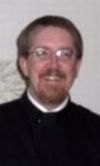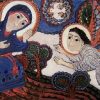Source: American Orthodox Institute
 In recent years, Orthodox Christians in the United States have become very mission minded. We see as a community the importance of bringing the Orthodox faith to what the U.S. Religious Landscape Survey published by the Pew Charitable Trust calls “the American religious marketplace.” Ours is a religious age characterized by “constant movement.”
In recent years, Orthodox Christians in the United States have become very mission minded. We see as a community the importance of bringing the Orthodox faith to what the U.S. Religious Landscape Survey published by the Pew Charitable Trust calls “the American religious marketplace.” Ours is a religious age characterized by “constant movement.”
Given the ease with which Americans change religious affiliations making new members is not the primary challenge. The real challenge, the Survey suggests, is retention, of actually keeping the members that we have. Our witness to the Gospel is undermined by the general lack of commitment to the life of the Church by a plurality of Orthodox Christians. And this is true whether we are talking about those baptized as infants or those who join the Church as adults. If anything, the empirical data highlights the pastoral importance of stressing not simply catechesis (religious education) evangelism (making new Orthodox Christians).
The survey data gives us an overview of religious life in American and the place of the Orthodox Church in this broader context. Filled with charts, graphs, and statistics the report is not something that most of us are likely just to pick and read. In what follows, rather than a rigorous statistical analysis of the Church’s life, I offer some points for reflection based on the survey. My goal is to help laity and clergy understand that catechesis and evangelism must be combined with a pastoral commitment to the personal discipleship of all members of the Church.
But, I’m getting ahead of myself.
To begin, let’s look at an Orthodox parish with an average Sunday attendance of say, 200 adults. (I’ve rounded numbers to make it a bit easier for us.)
Looking around, the congregation is evenly divided between men (94) and women (106). Most of the community members (154) were baptized as infants. Interestingly, about as many of here this morning were born overseas as became Orthodox Christians as adults (48 of were born outside the US and 46 are converts).
There are about 85 children under the age of 18 here this morning. And maybe this is where we might want to being thinking about the importance of personal discipleship.
Of the 85 or so children here this morning, only 64 or so will still be in church as adults. And, unless something changes, only about a third of these children will attend the Divine Liturgy on a weekly basis when they are adults. So in a few years time, this morning’s 85 children will shrink to a weekly congregation of 23 adults.
Surprisingly, at least relative to the American scene in general and the broader Christian community in particular, we’re doing good job in keeping children in the Church through adulthood. Almost three quarters of those who were raised as Orthodox Christians are still in the Church as adults compared to 68% of Catholics and 52% of Protestants adults are still members of their childhood tradition. Clearly we could be doing better, but we could be doing worse, much worse in fact.
“Well what about converts?” you might ask, “Certainly, their dedicated, right?” Well, not really, or at least not as much as we might imagine.
Of the 46 people at Liturgy this morning who joined the Church as adults, there are 46 or so more who have joined and subsequently left the Church. Roughly the same number of adult “cradle” and “convert” Orthodox Christians have left the Church (311,000 cradle Orthodox Christians have left vs. 364,000 converts). But when we look at the percentage, we see that the term “convert” is a bit of a misnomer since those who join as adults are almost twice as likely to leave the Church as those baptized as infants- 54% of all adult “converts” members vs. 35% of all adult “cradle” members. For every 10 converts who leave, 6 cradle adults also leave, or if you prefer, for every one Greek or Russian Orthodox baptized as an infant who will leave the Church, 1.6 adult converts will also leave. Converts leave at a 60% greater number than cradle Orthodox adults.
Pastorally solid catechesis and effective spiritual formation for all, laity and clergy alike is essential. Catechesis, in sermons and religious education classes for children and adults, tells me what we believe. Spiritual formation tells me, or better yet, helps me, answer questions such as “Who am I in Christ?” and “What is Christ asking of me?” Spiritual formation is concerned with answer questions of personal identity and vocation. In other words, formation is about discipleship, about a personal, life-long commitment to Christ. While the tradition of the Orthodox Church is almost unbelievably rich, it seems to me that we seriously neglect the formation of our laity (and as a result, our clergy).
“But, Father,” you might ask, “what about evangelism? Shouldn’t we simply work to fill the Church with new, committed, Orthodox Christians?”
Given the ease with which Americans change religious affiliations making new members is not a challenge. The real challenge is retention; of actually keeping the members that we have by helping them become disciples of Christ. The Church’s witness to the Gospel is undermined by a lack of commitment to Christ by a plurality of Orthodox Christians. Whether we are looking at the experience of “cradle” or “convert,” this commitment is absent for many Orthodox Christians. A credible witness is possible; we have the promise of Christ of this. But it requires from all of us a personal commitment to Christ, regular participation in the sacramental life of the Church (especially Holy Communion and Confession) and a willing eagerness of each of us to conform the whole of our life to Christ and the Gospel.
Fr Gregory Jensen, a native Texan, received his doctorate at Duquesne University’s Institute of Formative Spirituality in 1995, and was ordained to priesthood in 1996. Together with his wife Mary he served for 7 years as missionary in rural northern California where he also taught psychology and served as a consultant and trainer for area social service agencies. From 2003-2007, he was the Orthodox chaplain for the University of Pittsburgh and Carnegie Mellon University and is current the priest-in-charge at Holy Assumption Orthodox Church (OCA) in Canton, OH.
A psychologist of religion by profession, he has presented and published on theoretical and applied issues in clinical psychology, human developmental, pastoral theology, and Christian spirituality. An avid blogger and popular speaker, he maintains the blog Koinonia (www.palamas.info), is active in the Society St John Chrysostom, an ecumenical group devoted to Catholic/Orthodox reconciliation, and a frequent speaker at retreats and professional conferences.














